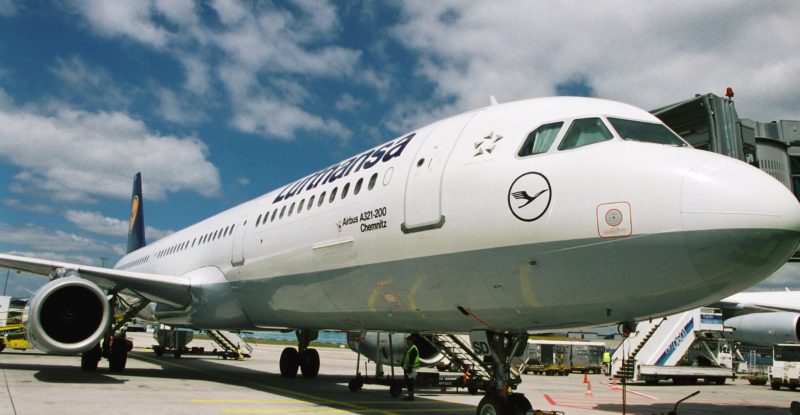 Spirits were flying high as we boarded the Lufthansa A321 at Malta, en route to Frankfurt on a test flight for the Inmarst Global Xpress (GX) inflight connectivity solution. Lufthansa Technik recently hosted a dozen journalists for the day, showing off the installation process and other aspects of its MRO facility on the island. We stopped atop the rear stairs to snap a photo of the radome on the fuselage and then headed inside, patiently waiting for the plane to reach cruising altitude so the service would activate.
Spirits were flying high as we boarded the Lufthansa A321 at Malta, en route to Frankfurt on a test flight for the Inmarst Global Xpress (GX) inflight connectivity solution. Lufthansa Technik recently hosted a dozen journalists for the day, showing off the installation process and other aspects of its MRO facility on the island. We stopped atop the rear stairs to snap a photo of the radome on the fuselage and then headed inside, patiently waiting for the plane to reach cruising altitude so the service would activate.
Much to our delight it came alive as we reached our cruising altitude and the mad dash of speed tests, video streaming and other consumption began. That euphoria was short-lived, grinding to a halt 15ish minutes later as the system dropped offline. The exact reason for the outage is unclear, though there was mention of issues with a ground station at various points.
Some 45 minutes later we were back online, testing again. Some passengers streamed videos. Others tried voice and video calls to the ground with mixed degrees of success. Your author pushed data up and down via FTP, plus published the requisite social media posts. My experience was inconsistent and bursty. Uploading an image to Twitter might stall for 15 seconds and then complete instantly. A second upload would show steady progress for the same 15 seconds. FTP was an even better indicator of the bursty nature of traffic, showing similar behavior of large chunks of data moving at an inconsistent pace.
https://twitter.com/InmarsatGlobal/status/842345043579043841
Some passengers were able to stream content off the plane via Periscope or Google Hangouts or Skype. I was unable to connect to those services, and typically received a message that the connection was too poor for streaming. Mentioning the failed calls on Twitter earned a reply that the services were blocked because of passenger feedback.
Some real-world upload numbers on @InmarsatGlobal #GX this morning. Lots of variation and retries. #ShowMeTheMegabits #PaxEX #LHTAvDays pic.twitter.com/Iy3K5ycyIf
— Seth Miller (@WandrMe) March 16, 2017
It is unclear if the inconsistency was per passenger or for the aircraft as a whole. In the first 15 minutes of being back online the system diagnostics showed 1.2 gigabytes of data downloaded and 1 gigabyte uploaded. With a couple dozen devices connected and many playing videos, that consumption level is a reasonable volume of traffic but it is hard to know how much went to whom.
 I was fortunate to have access on the same aircraft the day prior. We did not lose service that day and I was able to have a Skype call for a couple of minutes with reasonable latency and minimal jitter. I was able to watch short videos at 720p without issues the few times I tried. Still, the performance on that flight showed similar bursty behavior, with some slower moments again especially visible via FTP.
I was fortunate to have access on the same aircraft the day prior. We did not lose service that day and I was able to have a Skype call for a couple of minutes with reasonable latency and minimal jitter. I was able to watch short videos at 720p without issues the few times I tried. Still, the performance on that flight showed similar bursty behavior, with some slower moments again especially visible via FTP.
Ultimately the system looks to have great potential. When it was running smoothly the performance rivaled the Thales/ViaSat or Gogo 2Ku systems I’ve recently used. But it does not show the stability of more mature solutions. Hopefully the vendors can solve these problems quickly.
At least 57 Lufthansa Group aircraft are fitted with the kit and more are coming quickly. In January Lufthansa Group CEO Carsten Spohr indicated that the service was expected to transition from trial to production during the first quarter of this year. I would be concerned with deploying it in that mode given the inconsistency seen in the two flights I took.
And a quick Skype call with @WandrMe over GX, even better quality. Skype on a 15" MBP, filmed with 7+. #PaxEx #LHTAvDays pic.twitter.com/y4mgfOufLe
— John Walton • @thatjohn.bsky.social (@thatjohn) March 16, 2017
Lufthansa Technik covered the author’s travel for this media trip
Related Articles:











